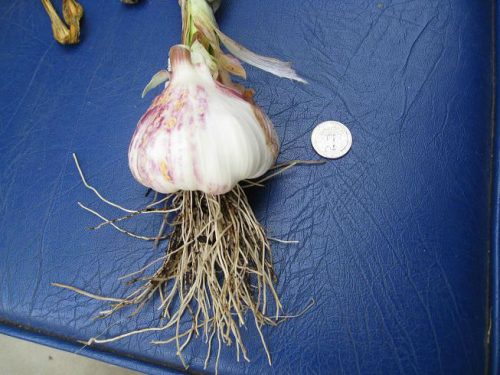We received a question this week on Ask Gardenerd that we wanted to share:
“Hi Christy, I’m wondering when the best time to plant shallots is in
SoCal? Also, do you have a good source for sets or is the farmer’s
market a good place to start? Thanks!”
Your timing is perfect! Fall is the best time to plant shallots in Southern California. They, like garlic, will overwinter and be harvested in springtime. They require similar care to garlic, with some exceptions. Here is a blurb from Peaceful Valley Farms, where you can order shallots for growing:
Preparing Soil For Shallots
Shallots are very tolerant and can be grown in acidic soil down to 5
pH, but prefer 6.0-6.8 pH. Plant in fertile, well-drained soil. The
looser the composition of the soil, the larger your shallots will grow.
Prepare your shallot bed by turning under or tilling in compost (be
sure to use compost that is fully aerobically broken down and contains
animal manures and plant residues, rather than cedar or redwood). Make
sure your soil has ample phosphorus. Gophers love shallots as much as
they like garlic; protect your beds with gopher wire or traps.
Planting Shallots & Growing Shallots
Shallots are planted from bulbs, rather than cloves like Garlic.
Separate multiple bulbs and plant each individual bulb, root end down.
Space shallot seeds 6″-8″ apart with 10″-12″ between rows. Plant just
deep enough so that the tip lies level with the soil surface. Unlike
garlic which forms a bulb from a clove, shallots will form a cluster of
5-12 bulbs around the original bulb. This cluster will spread out more
than a garlic bulb and therefore requires more space between plants.
Do not use mulch as it may rot bulbs, which are not strong enough to push
through mulch. After planting shallots, water well or lightly in heavy
soils, and only water again when the soil is dry. Remember, shallots
love water and food, but they must have good drainage or the bulbs will
rot.
In the Spring, feed the shallots with either composted
manure or a well-balanced fertilizer before the bulbs begin to enlarge.
Keep the bulbs well watered and weeded; they grow best with at least 1″
of water per week. Remove any seed stalks that form to focus the
shallots’ energy into forming bulbs. Shallots should be Spring planted
in very cold areas.
Harvesting Shallots & Storage
Harvest the shallots when the tops are drying. Pull up the clusters and
cure in a warm but shady place with ventilation. Regardless of what you
read elsewhere, do not leave your shallots in the sun to cure, because
they might sunburn and rot. Store your shallots in mesh bags (like
onion sacks) in a cool dry area. They can be stored for up to 8 months
if kept at their optimum storage temperature of 35°-45°F.
As for finding them in nurseries, I would call ahead to places like Marina Garden Center and Armstrong Garden Center to see if they have any in stock. Often you can start with shallots from the grocery store, but many alliums (and garlic and potatoes) have been sprayed to prevent sprouting. Also, by ordering from a nursery, you are guaranteeing that your starter bulbs are disease-free. Here is a direct link to Shallots at Peaceful Valley Farms:
Thanks for writing in! I hope this helps get your fall garden underway.


Pingback: YouTube: Growing Shallots and Garlic - Selection to Harvest - Gardenerd
Have you noticed that our SoCal “Indian Summers” are getting hotter? In Sept and Oct we seem to have more intensely hot “desert” days than cooler “marine layer” days. The sun is so intense, I have to keep my new fall crops in the shade or wait until late Oct. This is the fourth year that I have had to adjust my planting schedule.
I’ve been waiting until October for fall crops for a few years now, although last year, our marine layer was so thick that I took a dare and planted out crops in September, and it all worked out. I was picking kale by Halloween. This year, I’m waiting…only somewhat by choice. I’m so behind schedule, the little seedlings aren’t ready to go in the ground yet. Probably a good thing.
I tried shallots from seed this year and had pretty good luck. I live in a northern climate so I did start them inside. Most of them grew into single bulbs although a few did divide. They grew much larger than what I was getting from planting sets. Good Luck1
I love shallots! They add so much flavor to dishes and they’re so healthy for you. I like them much better than regular onions. They just seem more interesting to me.
With all the pollution in the environment it’s useful know ways to make your own food to know where’s come from
thanks for sharing this article thanks a lot.
These are great tips. I was able to plant my shallots in normal garden soil, though – no fertilizer needed. I keep an eye on the weeds and water regularly. There’s something about having shallots of my own that I love! They’re easy to maintain and taste delicious!
Great Going, I Like the entire article which is very interesting and informative too….. also the readers will be very happy to comment in it…. and I i am one of them..
Any one had any luck Shallot seeds? It sure would be a lot easier than saving half my crop.